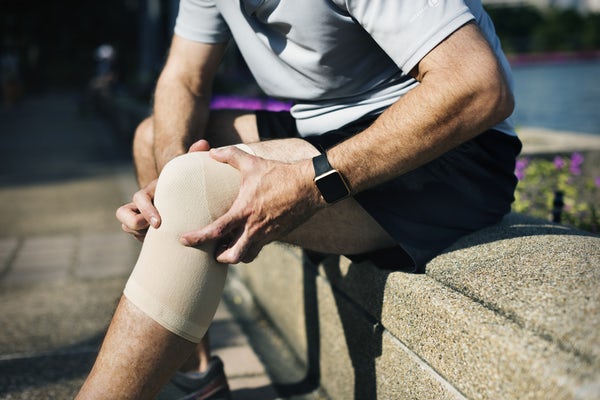Do you have knee pain when you run?
Where?
The front? Back? Side?
Does it happen as soon as you start running or after you get fatigued?
Is it worse on hills?
There are many causes of knee pain from running.
This article is the first in a series of 6 that will address various injuries that occur from running. The other topics include ITB (iliotibial band) syndrome, heel pain (plantar fasciitis), Achilles tendinitis, shin pain (medial tibial stress syndrome), and stress fractures. Stay tuned.
What if you have pain to the front or around your kneecap?
The technical name for this is patellofemoral pain. It is one of the most common injuries amongst runners.
How can you tell if you have patellofemoral pain?
There are several clues leading you to that conclusion.
- Do you experience knee pain when you sit for a long time?
- What about when you go to the movie theater? Is your knee sore after sitting through the movie?
- Does your knee “give way” when you walk?
- Does it hurt to squat?
- Is it painful to go up and downstairs?
- Does your knee hurt to run, especially down hills?
If you answered yes to several of these, you may have patellofemoral pain.
So, what is patellofemoral pain and why does it occur?
Patellofemoral pain is defined as pain around or under the kneecap (patella). The kneecap sits in a groove at the end of the thigh bone (femur).
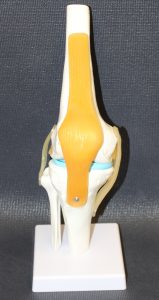
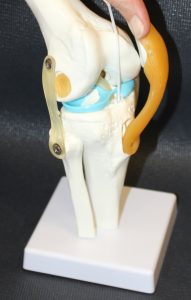
When you bend your knee, your kneecap should glide up and down in the groove. When it does not glide properly, pain may occur.
Why would the kneecap not glide properly in a healthy runner?
There are several reasons.
- Anatomical structure
- Muscle weakness
- Foot mechanics
- Shoe wear
- Running mechanics
To be clear, when you experience patellofemoral pain, it is usually due to something that is going on above or below the knee, not the knee itself. Let’s go through each problem.
Knee Pain from Anatomical Structure
This is not something you can change with exercise. Below are 3 common problems:
- Knock-kneed: The medical term for this is genu valgum. It means your knees angle in and touch each other when you stand. You cannot get your feet together when your knees are touching. This structural problem may cause the kneecap to glide improperly.
- Bow-legged: The medical term for this is genu varum. When you stand with your feet together, your knees do not touch. People who are bow-legged often joke they could easily ride a horse! This problem may also cause improper gliding of the kneecap.
- Knee hyperextension: The medical term for this is genu recurvatum. When standing, your knees over straighten. This may pose a problem because the muscles on the front of your thigh (quadriceps) do not have to work. Instead, you rest on the ligaments in the back of your knee, and your kneecap presses into the groove. When you don’t turn on your quads, they get weak and the quads help control the kneecap. This problem is more common in women. With conscious thought, this can be corrected by keeping your knees slightly unlocked, but it takes a lot of training to make it a habit.
There is not a lot you can do about your structure but there is something you can do about your strength.
Knee Pain from Muscle Weakness
A very common cause of knee pain is muscle weakness, especially hip weakness. The butt (gluteal) muscles stabilize the hip and keeps your knee properly aligned. With butt weakness, your knee may turn in or “cave in” when putting weight on that leg. If that happens, the kneecap will no longer glide in the groove properly and pain may occur.
Strengthening the butt muscles may help. Below are some exercise suggestions:
- Clams
- Side leg lifts
- Bridging
- Squats
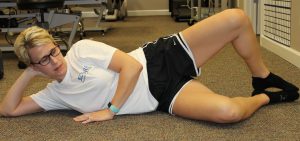
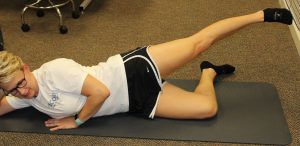
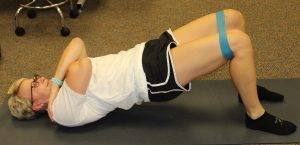
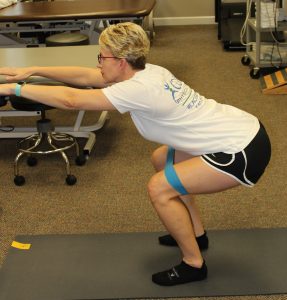
Top Row: Clams, Side Leg Lifts, Bridging; Bottom Row: Squat
Let’s go over how to perform each exercise:
- Clams: This works your butt muscles. Work on moving your hip joint only. Do not let your pelvis rollback. If it is too easy, add an elastic band around your knees.
- Side leg lifts: This exercise works the butt muscle that is responsible for keeping your pelvis level when you stand on one leg. It is critically important when you run to have strength in this muscle to support your body weight on that leg. When you perform this exercise, be sure to keep your thigh in line with your trunk or slightly behind. Do not let your leg migrate forward. Keep your knee straight.
- Bridging: Lift your butt while contracting your butt muscles. Keep your pelvis level. Do not overuse your hamstrings (muscles in the back of your thigh). If you experience cramping to the back of your thigh, it is because you are using your hamstrings too much and not using your butt enough. Concentrate on squeezing those “cheeks”! If you add an elastic band around your knees (as pictured), that will increase the difficulty. You may also be able to do a one-leg bridge by lifting one leg in the air and performing the exercise with the other leg. This greatly increases the difficulty. This is a good exercise to engage your butt without hurting your knee.
- Squat: This is an excellent exercise for the butt. However, if done improperly, it can cause knee pain. If this is new for you, a mirror or a friend who is comfortable with proper squatting technique may be helpful to give you proper cues. There are a lot of things to think about when performing the squat. First, pivot at your hips (stick your butt out) and then sit back as if you are sitting on a chair. Keep your back straight (don’t let it round). Keep your weight through your heels so your knees do move too far forward. Do not let your knees cave in toward one another. An elastic band around the knees will help kick in the butt muscles especially for those who have trouble keeping their knees apart.
If you have gone through these exercises for several weeks and have not noticed much change in your pain, look at your feet.
Knee Pain from Foot Mechanics
Do you have low arches?
High arches?
Do your feet roll in (arch flatten) or out when you walk?
Your shoe selection should be dependent on your foot type.
- LOW ARCHES: If your feet flatten when you walk, it is possible your feet are too flexible. As your foot rolls in, your knee may cave in altering the glide of the kneecap. If you have a flexible foot, you would benefit from a firm shoe (a stability shoe) and possibly an insert to prevent your feet and knees from caving in.
- HIGH ARCHES: If you have a high arch and it does not change much when walking, you probably have a rigid foot and would benefit from shoes that offer cushion (neutral shoe). Avoid shoes that are too rigid. Landing on a rigid foot does not allow for adequate shock absorption and may cause pain to not only the knee but many other joints.
You should consider consulting with a knowledgeable shoe salesperson who understands runners and can recommend appropriate shoe wear for your feet.
RunAbout Sports in Blacksburg VA does a great job. It would be worth paying them a visit.
If you have worked on your strength and checked your feet and are still having problems, your running mechanics may be the culprit.
Knee Pain from Running Mechanics
Are you a heel striker?
A large percentage of runners are heel-strikers (meaning they strike the ground with their heel first). If you fit this bill, you may be overstressing your knees.
One suggestion is to increase your step rate to reduce the stress on your knee. To figure out your step rate, count the number of steps you take in one minute while running at your normal pace. If it is less than 175 steps per minute, increase your step rate by 5-10%. Download a metronome app on your phone and set it to your “new” step rate. Run with the metronome to increase your cadence until you get comfortable with your new stride.
Other Problems?
These are just a few suggestions. There may be other ways to alleviate your pain.
If you have attempted to treat yourself and are not seeing an improvement, find a physical therapist trained to evaluate runners. Your therapist should have the ability to videotape and analyze your running mechanics. He or she should be able to figure out the cause of the pain and put you on an appropriate treatment plan.
Be aware that in most states, you are able to visit a therapist without going through a doctor first. This is called direct access. Call your therapist’s office. They will be able to tell you.
Hopefully, this will help you return to pain-free running. Good luck!

